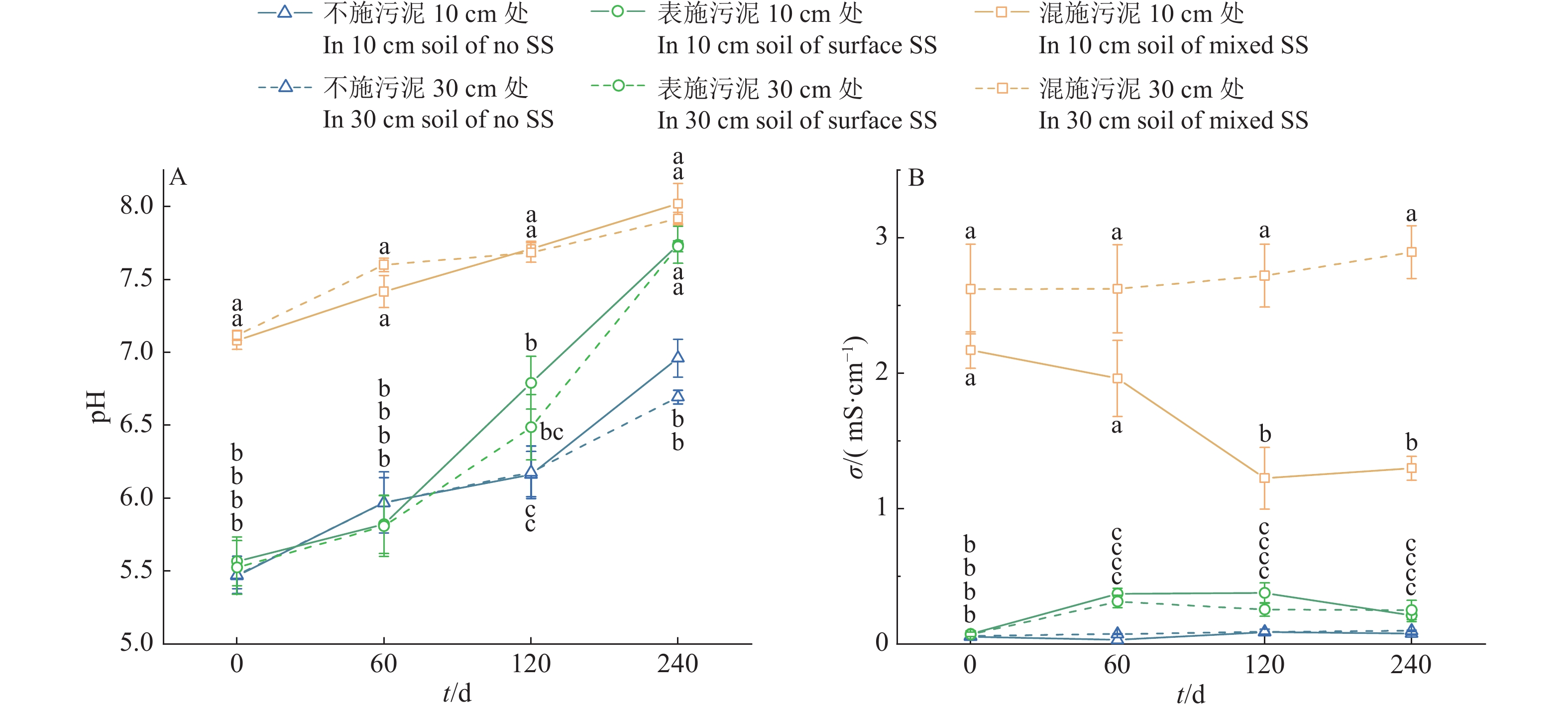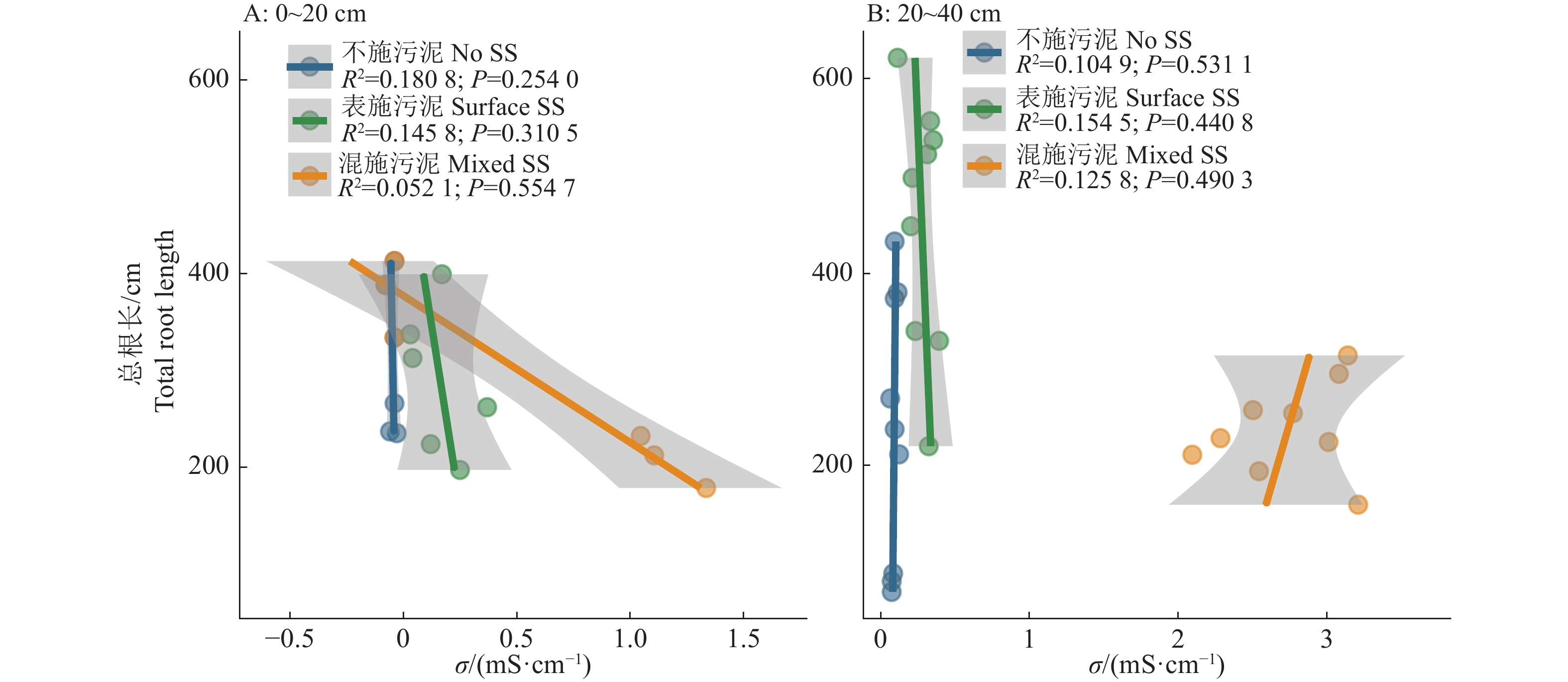Effects of sewage sludge application on root growth and heavy metal uptake of Schefflera arboricola
-
摘要:目的
分析表施和混施污泥对鹅掌藤Schefflera arboricola根系生长和重金属吸收的影响,深入认识污泥施用对园林植物根系生长的影响,为污泥在园林中安全利用提供借鉴。
方法采用根箱试验,观测不施、表施和混施10%(w)污泥对常见园林植物鹅掌藤的不同土层根系形态及土壤pH和电导率动态变化的影响,分析根组织密度、根密度和重金属含量,拟合土壤pH、电导率、根系重金属含量与根长的关系。
结果与不施污泥相比,混施污泥明显抑制鹅掌藤根长、根表面积和根密度增长;而表施污泥显著增加鹅掌藤0~20 cm土层的总根长、根体积和根密度。处理240 d后,混施污泥处理的0~20与20~40 cm土层总根长分别为不施污泥的66.37%和51.51%,而表施污泥处理分别为不施污泥的115.43%和98.66%。最大总根长、根体积和根密度均出现在表施污泥的0~20 cm土层,最大根干质量和根组织密度出现在表施污泥的污泥层。混施污泥显著提高了土壤pH和电导率以及植株重金属含量,不同土层根系Cd、Zn、Cu和Ni含量分别是不施污泥的2.32~11.70倍。线性回归拟合分析表明,不施和表施污泥处理的0~20 cm土层鹅掌藤原位扫描总根长均与原位测定土壤pH呈极显著正相关(P<0.001),鹅掌藤总根长与根系Cd、Zn、Cu和Ni含量均呈极显著负相关(P<0.001)。
结论表施10%(w)污泥可以提高土壤pH并促进鹅掌藤根系生长。混施10%(w)污泥显著增加不同土层根系重金属含量,进而抑制鹅掌藤根系生长。
Abstract:ObjectiveThis study aimed to analyze the effect of sewage sludge (SS) surface and mixed application on Schefflera arboricola root growth and heavy metals uptake, to deeply understand the effect of SS application on landscape plant root growth, and to provide a reference for the safe use of SS in the landscape.
MethodWe conducted a root box experiment without SS (no SS) and with the surface application (surface SS) or the mixed application (mixed SS) of 10% SS, to analyze the dynamic changes of S. arboricola root morphology, soil pH, and conductivity in different soil layers. Root tissue density, root density, and heavy metal contents of plant were also analyzed. The relationships between soil pH, soil conductivity, root heavy metal contents, and root length were further established by the linear regression analysis.
ResultCompared with no SS, mixed SS treatment obviously inhibited the increment of root length, root surface area, and root density. Surface SS treatment significantly increased total root length, root volume, and root density in the 0−20 cm soil layer. After 240 days of treatment, total root length in 0−20 cm and 20−40 cm layers in mixed SS treatment were 66.37% and 51.51% of no SS, respectively. Those for surface SS treatment were 115.43% and 98.66% of no SS, respectively. The maximum root total length, root volume, and root density occurred in the 0−20 cm soil layer in surface SS treatment, while the maximum root dry weight and tissue density occurred in the SS layer in surface SS treatment. Mixed SS treatment significantly increased soil pH, soil conductivity, and heavy metal contents of S. arboricola. The contents of Cd, Zn, Cu, and Ni in roots of different soil layers in mixed SS treatment were 2.32 to 11.70 times higher than those in no SS treatment. The linear regression analysis showed that the in-situ scanning total root length of S. arboricola in 0−20 cm soil layers was significantly positively correlated with in-situ measured soil pH in no SS and surface SS treatment (P<0.001). Total root length of S. arboricola was significantly negatively correlated with the contents of Cd, Zn, Cu, and Ni in roots (P<0.001).
ConclusionSurface application of 10% SS increases soil pH and promotes S. arboricola root growth. Mixed application of 10% SS significantly increases root heavy metal uptake in different soil layers and inhibits root growth of S. arboricola.
-
Keywords:
- Sewage sludge /
- Landscape application /
- Landscape plant /
- Root morphology /
- Heavy metal /
- pH /
- Schefflera arboricola
-
-
图 1 原位扫描鹅掌藤总根长、根表面积和根体积变化
SS:污泥;柱子上方的不同小写字母表示不同时间的同一处理同一土层的数值差异显著(P<0.05,0~20 cm土层使用Duncan’s法,不施污泥层与20~40 cm土层使用t检验);柱子上方的不同大写字母表示不同处理的同一时间同一土层的数值差异显著(P<0.05,Duncan’s法)
Figure 1. Changes of total root length, root surface area and root volume
in Schefflera arboricola by in-situ scanning SS: Sewage sludge; Different lowercase letters on the bars indicate significant differences among the same treatment at different times for the same soil layer (P<0.05, Duncan’s method was used for 0−20 cm soil layer, and t test was used for no SS layer and 20−40 cm soil layer); Different capital letters on the bars indicate significant differences among different treatments at the same time for the same soil layer (P<0.05, Duncan’s method)
表 1 土壤及堆肥污泥的基本性质
Table 1 Basic properties of soil and composted sludge
试验材料
Testing
materialpH σ/
(mS·cm−1)w(有机质)/
(g·kg−1)
Organic matter
contentw/(mg·kg−1) 碱解氮
Available
N有效磷
Available
P速效钾
Available
KCd Ni Cu Zn 土壤 Soil 4.68 0.05 2.48 67.26 4.56 47.65 0.12 9.77 20.58 37.93 污泥 Sewage sludge 7.86 3.35 178.35 1 496.48 695.67 498.37 2.39 47.96 419.50 1070.37 表 2 收获后根系干质量及相关指标1)
Table 2 Root dry weight and other indexes after harvest
处理
Treatment土层/ cm
Soil layer根干质量/g
Root dry weight总根长/cm
Total root length根体积/cm3
Root volume比根长/(cm∙g−1)
Specific root length根组织密度/(g∙cm−3)
Root tissue density根密度/(cm∙cm−3)
Root density不施污泥
No SS0~20 6.55±0.74ab 1 140.39±31.00b 2.83±0.09b 177.56±16.38a 2.33±0.33a 0.19±0.01b 20~40 3.02±0.08ab 1 152.36±33.32a 3.18±0.29a 381.99±18.64a 0.96±0.0.07a 0.19±0.01a 表施污泥
Surface SS污泥层SS 13.28±0.59A 430.92±25.68C 1.51±0.26B 32.59±2.38C 9.30±1.38A 0.14±0.01B 0~20 8.54±0.94aB 1 316.34±33.77aA 3.71±0.27aA 158.14±18.07aB 2.36±0.39aB 0.22±0.01aA 20~40 4.10±0.72aC 1 136.90±71.77aB 3.31±0.30aA 297.68±58.97aA 1.27±0.29aB 0.19±0.01aA 混施污泥
Mixed SS0~20 4.53±0.79b 756.92±33.66c 2.21±0.10c 182.20±43.92a 2.07±0.39a 0.13±0.01c 20~40 1.75±0.33b 593.57±13.14b 2.39±0.17b 369.57±83.47a 0.74±0.16b 0.10±0.00b 1)表中数据为平均值±标准误,n=3;同列数据后的不同小写字母表示同一土层的不同处理间差异显著(P<0.05,Duncan’s法);同列数据后的不同大写字母表示表施污泥处理不同土层间差异显著(P<0.05,Duncan’s法)
1)Values in table are means±SE, n=3; Different lowercase letters after the data in the same column indicate significant differences in the same soil layer among different treatments (P<0.05, Duncan’s method); Different capital letters after the data in the same column indicate significant differences among different soil layers treated with surface sewage sludge (P<0.05, Duncan’s method)表 3 鹅掌藤根系重金属含量1)
Table 3 Heavy metal contents in root of Schefflera arboricola
处理
Treatment土层/cm
Soil layerw/(mg∙kg−1) Cd Zn Cu Ni 不施污泥
No SS0~20 0.23±0.02b 13.61±2.74c 15.39±6.38b 2.34±0.24b 20~40 0.35±0.07b 14.16±2.17b 19.51±3.80b 1.99±0.06b 表施污泥
Surface SS污泥层SS 1.43±0.31A 83.88±1.75A 48.64±2.25A 18.11±0.35A 0~20 1.14±0.21bA 27.38±6.02bB 24.51±8.42bB 2.76±0.96bB 20~40 0.95±0.10bA 18.94±2.60bB 11.28±0.41bB 2.84±0.60bB 混施污泥
Mixed SS0~20 2.69±0.50a 54.69±1.39a 46.74±1.96a 12.53±1.87a 20~40 2.32±0.47a 50.49±1.49a 45.26±1.94a 13.24±0.59a 1) 表中数据为平均值±标准误,n=3;同列数据后的不同小写字母表示同一土层的不同处理间差异显著(P<0.05,Duncan’s法);同列数据后的不同大写字母表示表施污泥处理不同土层间差异显著(P<0.05,Duncan’s法)
1) Values in table are means ± SE, n=3; Different lowercase letters after the data in the same column indicate significant differences in the same soil layer among different treatments (P<0.05, Duncan’s method); Different capital letters after the data in the same column indicate significant differences among different soil layers treated with surface sewage sludge (P<0.05, Duncan’s method) -
[1] YAKAMERCAN E, ARI A, AYGÜN A. Land application of municipal sewage sludge: Human health risk assessment of heavy metals[J]. Journal of Cleaner Production, 2021, 319: 128568. doi: 10.1016/j.jclepro.2021.128568.
[2] 安叶, 张义斌, 黎攀, 等. 我国市政生活污泥处置现状及经验总结[J]. 给水排水, 2021, 57(S1): 94-98. [3] JAFFAR ABDUL KHALIQ S, AHMED M, AL-WARDY M, et al. Wastewater and sludge management and research in Oman: An overview[J]. Journal of the Air & Waste Management Association, 2017, 67(3): 267-278.
[4] 王丽霞, 杜子文, 封莉, 等. 连续施用城市污泥后林地土壤中重金属的含量变化及生态风险[J]. 环境工程学报, 2021, 15(3): 1092-1102. doi: 10.12030/j.cjee.202001001 [5] LIU H. Achilles heel of environmental risk from recycling of sludge to soil as amendment: A summary in recent ten years (2007–2016)[J]. Waste Management, 2016, 56: 575-583. doi: 10.1016/j.wasman.2016.05.028
[6] KCHAOU R, BACCAR R, BOUZID J, et al. The impact of sewage sludge and compost on winter triticale[J]. Environmental Science and Pollution Research, 2018, 25(19): 18314-18319. doi: 10.1007/s11356-017-0609-7
[7] SI L Q, PENG X W, ZHOU J X. The suitability of growing mulberry (Morus alba L. ) on soils consisting of urban sludge composted with garden waste: A new method for urban sludge disposal[J]. Environmental Science and Pollution Research, 2019, 26(2): 1379-1393. doi: 10.1007/s11356-018-3635-1
[8] RELLÁN-ÁLVAREZ R, LOBET G, DINNENY J R. Environmental control of root system biology[J]. Annual Review of Plant Biology, 2016, 67: 619-642. doi: 10.1146/annurev-arplant-043015-111848
[9] 阮可瑾, 谢宝玥, 邓应生, 等. 铁冬青幼苗对污染土壤中铅、镉的耐受、吸收和累积[J]. 华南农业大学学报, 2022, 43(3): 50-58. doi: 10.7671/j.issn.1001-411X.202107043 [10] 张万锋, 杨树青, 娄帅, 等. 耕作方式与秸秆覆盖对夏玉米根系分布及产量的影响[J]. 农业工程学报, 2020, 36(7): 117-124. doi: 10.11975/j.issn.1002-6819.2020.07.013 [11] CORREA J, POSTMA J A, WATT M, et al. Soil compaction and the architectural plasticity of root systems[J]. Journal of Experimental Botany, 2019, 70(21): 6019-6034. doi: 10.1093/jxb/erz383
[12] WU D, YU X, LAI M, et al. Diversified effects of co-planting landscape plants on heavy metals pollution remediation in urban soil amended with sewage sludge[J]. Journal of Hazardous Materials, 2021, 403: 123855. doi: 10.1016/j.jhazmat.2020.123855.
[13] KOWALIK R, WIDŁAK M, WIDŁAK A. Sorption of heavy metals by sewage sludge and its mixtures with soil from wastewater treatment plants operating in MBR and INR technology[J]. Membranes, 2021, 11(9): 706. doi: 10.3390/membranes11090706.
[14] 丁洪, 余居华, 郑祥洲, 等. 中国城市污泥应用对作物产量、品质和土壤质量的影响[J]. 生态环境学报, 2021, 30(9): 1933-1942. [15] 吴道铭, 张书源, 董晓全, 等. 根箱法原位分析黄梁木幼苗移栽后的根系生长[J]. 中南林业科技大学学报, 2020, 40(7): 9-17. [16] 李燕丽, 王昌昆, 卢碧林, 等. 基于微根管技术的盐胁迫下小麦根系生长原位监测方法[J]. 土壤学报, 2021, 58(3): 599-609. [17] DEBOSZ K, PETERSEN S O, KURE L K, et al. Evaluating effects of sewage sludge and household compost on soil physical, chemical and microbiological properties[J]. Applied Soil Ecology, 2002, 19(3): 237-248. doi: 10.1016/S0929-1393(01)00191-3
[18] 徐玉玲, 冯巩俐, 蒋晓煜, 等. 兰州市某交通干道土壤重金属分布特征及其对绿化植物的影响[J]. 应用生态学报, 2020, 31(4): 1341-1348. [19] 姚佳璇, 俄胜哲, 袁金华, 等. 城市污泥农用对灌漠土作物产量及土壤质量的影响[J]. 生态学杂志, 2021, 40(7): 2120-2132. [20] 谢换换, 叶志鸿. 湿地植物根形态结构和泌氧与盐和重金属吸收、积累、耐性关系的研究进展[J]. 生态学杂志, 2021, 40(3): 864-875. [21] ZHANG H, QI H Y, ZHANG Y L, et al. Effects of sewage sludge pretreatment methods on its use in agricultural applications[J]. Journal of Hazardous Materials, 2022, 428: 128213. doi: 10.1016/j.jhazmat.2022.128213.
[22] WU D, CHU S, LAI C, et al. Application rate and plant species affect the ecological safety of sewage sludge as a landscape soil amendment[J]. Urban Forestry and Urban Greening, 2017, 27: 138-147. doi: 10.1016/j.ufug.2017.07.003
[23] HU X F, LI W T, LIU Q H, et al. Root physiological responses can explain the effects of short-term plant-plant interactions on growth of two subalpine coniferous species[J]. Canadian Journal of Forest Research, 2021, 51(11): 1595-1606. doi: 10.1139/cjfr-2020-0542
[24] CHUNTHABUREE S, DONGSANSUK A, SANIT-CHON J, et al. Physiological and biochemical parameters for evaluation and clustering of rice cultivars differing in salt tolerance at seedling stage[J]. Saudi Journal of Biological Sciences, 2016, 23(4): 467-477.
[25] 董晓芸, 柯凯恩, 胡自航, 等. 施用不同污泥堆肥对土壤理化性质及微生物活性的影响[J]. 东北林业大学学报, 2021, 46(6): 70-75. doi: 10.3969/j.issn.1000-5382.2021.06.014 [26] BELHAJ D, ELLOUMI N, JERBI B, et al. Effects of sewage sludge fertilizer on heavy metal accumulation and consequent responses of sunflower (Helianthus annuus)[J]. Environmental Science and Pollution Research, 2016, 23(20): 20168-20177.
[27] HE J Y, ZHU C, REN Y F, et al. Root morphology and cadmium uptake kinetics of the cadmium-sensitive rice mutant[J]. Biologia Plantarum, 2007, 51(4): 791-794. doi: 10.1007/s10535-007-0162-1
[28] CHAI M W, SHI F C, LI R L, et al. Effect of NaCl on growth and Cd accumulation of halophyte Spartina alterniflora under CdCl2 stress[J]. South African Journal of Botany, 2013, 85: 63-69. doi: 10.1016/j.sajb.2012.12.004
[29] 陈方圆, 古勇波, 白江珊, 等. 淹水和盐胁迫对湿地植物菰生长的影响[J]. 生态学杂志, 2020, 39(5): 1484-1491. [30] TURNER A J, ARZOLA C I, NUNEZ G H. High pH stress affects root morphology and nutritional status of hydroponically grown Rhododendron (Rhododendron spp.)[J]. Plants, 2020, 9(8): 1019. doi: 10.3390/plants9081019.
[31] 廉梅花. 根际土壤中重金属的活化因素及作用机理研究[D]. 沈阳: 东北大学, 2015. [32] AHN T I, SHIN J H, SON J E. Theoretical and experimental analyses of nutrient control in electrical conductivity-based nutrient recycling soilless culture system[J]. Frontiers in Plant Science, 2021, 12: 656403. doi: 10.3389/fpls.2021.656403.
[33] KOMINKO H, GORAZDA K, WZOREK Z. Effect of sewage sludge-based fertilizers on biomass growth and heavy metal accumulation in plants[J]. Journal of Environmental Management, 2022, 305: 114417. doi: 10.1016/j.jenvman.2021.114417.
[34] 列志旸. 华南地区7种园林植物的耐盐性评价研究[D]. 广州: 华南农业大学, 2017. [35] MAHMOOD S, ISHTIAQ S, YASIN G, et al. Dose dependent rhizospheric Ni toxicity evaluation: Membrane stability and antioxidant potential of Vigna species[J]. Chilean Journal of Agricultural Research, 2016, 76(3): 378-384. doi: 10.4067/S0718-58392016000300017
[36] SRIVASTAVA S, SRIVASTAVA A K, SUPRASA- NNAP, et al. Comparative biochemical and transcriptional profiling of two contrasting varieties of Brassica juncea L. in response to arsenic exposure reveals mechanisms of stress perception and tolerance[J]. Journal of Experimental Botany, 2009, 60(12): 3419-3431.




 下载:
下载:




